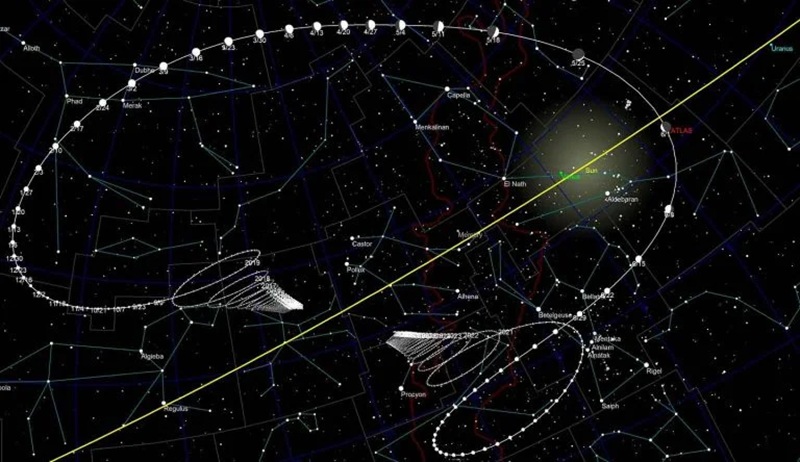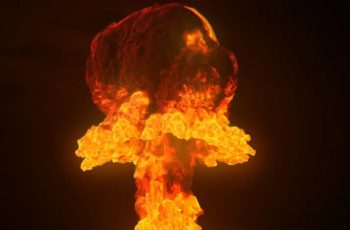Astronomers are excited about the comet ATLAS (C/2024 G3), which has reached the brightness of Venus and is visible in the Northern Hemisphere. The comet, discovered in April 2024, has become so bright that it is now visible even during the day. This extraordinary sight has generated both awe and speculation, with some linking its appearance to the potential for catastrophic events, including the possibility of World War III.

Captured in stunning photographs, such as one by Petr Horalek in the Czech Republic, the comet’s increasing brightness has thrilled astronomers. It has even been spotted in daylight by British astronomers, which is a rare occurrence. Initially, the comet didn’t promise major surprises, but as it approaches the Sun, it has grown brighter each day.
Comet ATLAS (C/2024 G3) has an orbital period of approximately 160,000 years and is currently about 157.8 million kilometers from Earth in the constellation Sagittarius. On January 13, 2025, the comet will make its closest approach to the Sun, coming within 0.1 AU—four times closer than Mercury. This proximity could significantly increase its brightness or cause it to explode.
The comet’s brightness and unusual appearance have led some to believe it is an omen of impending global upheaval, similar to the historical “Comets of War” which were thought to appear six months before major conflicts. The appearance of four comets since 2024, with two visible in daylight, has intensified these fears. Some interpret the occurrence of these comets, especially ATLAS (C/2024 G3), as a sign of catastrophic events on Earth.
While astronomers have used telescopes to track the comet’s movements, its size remains uncertain. This uncertainty has given rise to speculation, particularly among “nibirologists,” who believe the comet may not be a comet at all. They suggest that if the comet explodes, it could create a fiery cross in the sky, a symbol associated with the mythical planet Nibiru.
The appearance of ATLAS (C/2024 G3) has reignited fears and discussions about the possibility of dramatic and transformative events. Some believe that the comet’s presence could be a harbinger of World War III, while others see it as a fascinating celestial event. Regardless, the comet has sparked renewed interest in the mysteries of the universe and the potential for extraordinary occurrences on Earth.
The prophecies surrounding Nibiru suggest that if Earth were to encounter the planet, it could be due to the collision and explosion of two comets—possibly what we are witnessing now with ATLAS.Astronomers are excited about the comet ATLAS (C/2024 G3), which has reached the brightness of Venus and is visible in the Northern Hemisphere. The comet, discovered in April 2024, has become so bright that it is now visible even during the day. This extraordinary sight has generated both awe and speculation, with some linking its appearance to the potential for catastrophic events, including the possibility of World War III.
Captured in stunning photographs, such as one by Petr Horalek in the Czech Republic, the comet’s increasing brightness has thrilled astronomers. It has even been spotted in daylight by British astronomers, which is a rare occurrence. Initially, the comet didn’t promise major surprises, but as it approaches the Sun, it has grown brighter each day.
Comet ATLAS (C/2024 G3) has an orbital period of approximately 160,000 years and is currently about 157.8 million kilometers from Earth in the constellation Sagittarius. On January 13, 2025, the comet will make its closest approach to the Sun, coming within 0.1 AU—four times closer than Mercury. This proximity could significantly increase its brightness or cause it to explode.
The comet’s brightness and unusual appearance have led some to believe it is an omen of impending global upheaval, similar to the historical “Comets of War” which were thought to appear six months before major conflicts. The appearance of four comets since 2024, with two visible in daylight, has intensified these fears. Some interpret the occurrence of these comets, especially ATLAS (C/2024 G3), as a sign of catastrophic events on Earth.
While astronomers have used telescopes to track the comet’s movements, its size remains uncertain. This uncertainty has given rise to speculation, particularly among “nibirologists,” who believe the comet may not be a comet at all. They suggest that if the comet explodes, it could create a fiery cross in the sky, a symbol associated with the mythical planet Nibiru.
The appearance of ATLAS (C/2024 G3) has reignited fears and discussions about the possibility of dramatic and transformative events. Some believe that the comet’s presence could be a harbinger of World War III, while others see it as a fascinating celestial event. Regardless, the comet has sparked renewed interest in the mysteries of the universe and the potential for extraordinary occurrences on Earth.

The prophecies surrounding Nibiru suggest that if Earth were to encounter the planet, it could be due to the collision and explosion of two comets—possibly what we are witnessing now with ATLAS.


